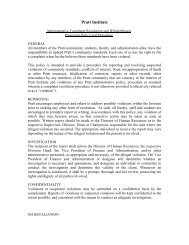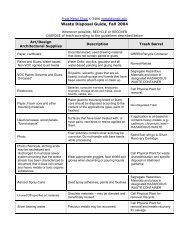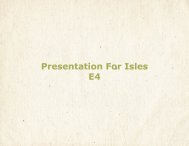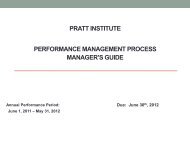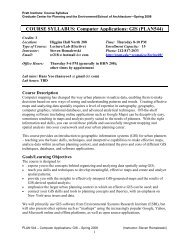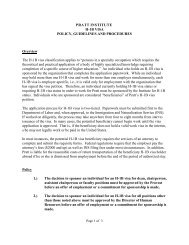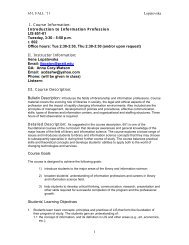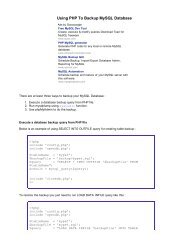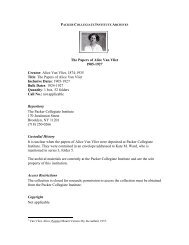Alex Nysten - The Role of Animation in Propaganda
Alex Nysten - The Role of Animation in Propaganda
Alex Nysten - The Role of Animation in Propaganda
Create successful ePaper yourself
Turn your PDF publications into a flip-book with our unique Google optimized e-Paper software.
YASMINA ALEXANDRA NYSTEN<br />
<strong>The</strong> role <strong>of</strong> animation <strong>in</strong> <strong>Propaganda</strong><br />
COMMUNIST PROPAGANDA (Russia)<br />
A case <strong>of</strong> bra<strong>in</strong> wash propaganda<br />
From 1924 to perestroika the USSR produced more than 4<br />
dozen animated propaganda films. <strong>The</strong>y weren't for export.
<strong>The</strong>ir target was the new nation and their goal was to w<strong>in</strong><br />
over the hearts and m<strong>in</strong>ds <strong>of</strong> the Soviet people. Anti-<br />
American, Anti-British, Anti-German, Anti-Capitalist, Anti-<br />
Fascist, some <strong>of</strong> these films are as artistically beautiful<br />
as the great political posters made after the 1917<br />
revolution which <strong>in</strong>spired Soviet animation.<br />
http://video.aol.com/video-detail/animated-sovietpropaganda-american-imperialists/2930446298<br />
AMERICAN PROPAGANDA<br />
A case <strong>of</strong> propaganda as a tool <strong>of</strong> war<br />
Between 1942 and 1945, dur<strong>in</strong>g World War II, Walt Disney was<br />
<strong>in</strong>volved <strong>in</strong> the production <strong>of</strong> propaganda for the US<br />
government. <strong>The</strong> widespread familiarity <strong>of</strong> Walt Disney's<br />
productions benefited the US government <strong>in</strong> produc<strong>in</strong>g pro-<br />
American war propaganda <strong>in</strong> an effort to <strong>in</strong>crease support<br />
for the war.<br />
Dur<strong>in</strong>g World War II, Disney made films for every branch <strong>of</strong><br />
the US military and government. <strong>The</strong> government looked to<br />
Walt Disney more than any other studio chief as a builder<br />
<strong>of</strong> public morale provid<strong>in</strong>g <strong>in</strong>struction and tra<strong>in</strong><strong>in</strong>g to the<br />
sailors and soldiers."This was accomplished through the use<br />
<strong>of</strong> animated graphics by means <strong>of</strong> expedit<strong>in</strong>g the <strong>in</strong>telligent<br />
mobilization <strong>of</strong> servicemen and civilians for the cause <strong>of</strong><br />
the war. Over 90% <strong>of</strong> Disney employees were devoted to the<br />
production <strong>of</strong> tra<strong>in</strong><strong>in</strong>g and propaganda films for the<br />
government.Throughout the duration <strong>of</strong> the war, Disney<br />
produced over 400,000 feet <strong>of</strong> educational war films, most<br />
at cost, which is equal to 68 hours <strong>of</strong> cont<strong>in</strong>uous film.<br />
In 1942, Disney was approached with requests from the US<br />
services. <strong>The</strong> Navy was the first, and other branches <strong>of</strong> the<br />
government, <strong>in</strong>clud<strong>in</strong>g, the Army, the Air Force, the<br />
Department <strong>of</strong> Agriculture, and the Treasury Department,<br />
rapidly caught on to Disney’s creative approach to<br />
generat<strong>in</strong>g educational films, propaganda and <strong>in</strong>signias.
As requested by the US Government, Walt Disney created a<br />
number <strong>of</strong> anti-German and anti-Japanese films for both the<br />
soldiers and the US public. He wanted to portray these<br />
countries and their leaders as manipulative without morals.<br />
A few <strong>of</strong> the films he produced were "Der Fuehrer's Face”<br />
(1942), “Education for Death- <strong>The</strong> Mak<strong>in</strong>g <strong>of</strong> a Nazi” (1943),<br />
and “Commando Duck" (1944).<br />
In “Der Fuehrer’s Face,” Donald Duck breaks down after<br />
experienc<strong>in</strong>g a nightmare where he has to make do with<br />
eat<strong>in</strong>g disgust<strong>in</strong>g Nazi food rations and experiences a day<br />
at a Nazi artillery factory. “Education for Death- <strong>The</strong><br />
Mak<strong>in</strong>g <strong>of</strong> a Nazi” was a wartime propaganda film that takes<br />
on the perspective <strong>of</strong> Hans, a young German boy. As the<br />
movie progresses and Hans is exposed to Hitler youth and<br />
the Nazi culture, his value <strong>of</strong> human life decreases. In<br />
“Commando Duck”, Donald, by himself, destroys an entire<br />
Japanese airbase<br />
DONALD DUCK: http://video.google.com/videosearch?<br />
client=safari&rls=en&q=Der%20Fuehrer’s%20Face&oe=UTF-<br />
8&um=1&ie=UTF-8&sa=N&hl=en&tab=wv#
NAZI PROPAGANDA<br />
the case <strong>of</strong> Hans<br />
Fischerkoesen<br />
A case that is "antipropagandic"<br />
<strong>in</strong> it's<br />
propaganda<br />
After World War II<br />
started, the trickle <strong>of</strong><br />
cartoons produced by<br />
German studios was not<br />
enough to cover the loss<br />
<strong>of</strong> Disney and other<br />
American product. To<br />
rectify the situation, <strong>in</strong><br />
1941 the Nazi government<br />
called for the<br />
establishment <strong>of</strong> a strong<br />
German animation <strong>in</strong>dustry capable <strong>of</strong> produc<strong>in</strong>g both color<br />
cartoons and animated features. Thus, all able animators<br />
were commanded to step up production and focus on<br />
theatrically viable cartoons. Among the filmmakers called<br />
<strong>in</strong>to action was Hans Fischerkoesen, who was among the most<br />
dist<strong>in</strong>guished animators rema<strong>in</strong><strong>in</strong>g <strong>in</strong> Germany between 1933<br />
and 1945, and whose work dur<strong>in</strong>g the war years <strong>in</strong>cluded a<br />
trio <strong>of</strong> remarkable films: Verwitterte Melodie (Weatherbeaten<br />
Melody, 1942), Der Schneemann (<strong>The</strong> Snowman, 1943)<br />
and Das dumme Gänsle<strong>in</strong> (<strong>The</strong> Silly Goose, 1944).<br />
Weather-beaten Melody<br />
video: http://www.youtube.com/watch?v=3dKQLUqgB-0<br />
Precisely because <strong>of</strong> its technical brilliance, Weatherbeaten<br />
Melody could get away with quite a bit <strong>of</strong> forbidden<br />
<strong>in</strong>formation.He del<strong>in</strong>eates her personality with unexpected
complexities. For example, is she jealous <strong>of</strong> the hedgehog<br />
who takes over her place as "phonograph needle" when she is<br />
away sharpen<strong>in</strong>g her st<strong>in</strong>ger--or is she merely exasperated<br />
at the confus<strong>in</strong>g quality <strong>of</strong> his multi-needle pickup? <strong>The</strong><br />
very idea <strong>of</strong> ambiguity was anathema to the Nazis, who could<br />
only hope to ma<strong>in</strong>ta<strong>in</strong> their fascist program by enforc<strong>in</strong>g<br />
strict, unbend<strong>in</strong>g codes <strong>of</strong> behavior, and absolute,<br />
<strong>in</strong>violable "ideals and truths."Ironically, <strong>in</strong>herent <strong>in</strong> the<br />
"stereo" animation techniques, as Fischerkoesen uses them,<br />
lies the most subversive metaphor: a sense <strong>of</strong> freedom <strong>of</strong><br />
movement, an affirmation <strong>of</strong> the multi-layered nature <strong>of</strong><br />
reality--<strong>of</strong> ambiguity and change--which demands (even<br />
subconsciously) that the viewer th<strong>in</strong>k for herself and<br />
consider other th<strong>in</strong>gs as valid as the subjective self--<br />
someth<strong>in</strong>g truly forbidden by Nazi doctr<strong>in</strong>e as the most<br />
dangerous action <strong>of</strong> all.To fully appreciate Fischerkoesen's<br />
dar<strong>in</strong>g, one must remember that the Nazis had forbidden jazz<br />
and sw<strong>in</strong>g as an Afro-Judaic plot to underm<strong>in</strong>e traditional<br />
German culture.<br />
n this context, the discovery <strong>of</strong> an abandoned phonograph<br />
takes on new mean<strong>in</strong>g, especially when the record on the<br />
turntable is a sw<strong>in</strong>g number with lyrics that say, "<strong>The</strong> week<br />
wouldn't be worthwhile without a weekend when we can get<br />
away to enjoy nature." Near the phonograph lies an<br />
"abandoned" clasp from a woman's garter belt (with a lucky<br />
four-leafed clover grow<strong>in</strong>g out <strong>of</strong> it!), which suggests that<br />
the <strong>in</strong>terrupted picnic that left beh<strong>in</strong>d the musical<br />
<strong>in</strong>strument had also <strong>in</strong>volved erotic play--someth<strong>in</strong>g also<br />
strictly forbidden by the puritanical Nazi codes. So from<br />
beneath the charm<strong>in</strong>g surface <strong>of</strong> this cartoon emerges a<br />
subversive message: women, far from the unnatural Nazidesignated<br />
stereotype <strong>of</strong> "children, church and kitchen,"<br />
can escape <strong>in</strong>to Nature to be self-reliant and adventurous,<br />
erotic and free--they can rediscover or revitalize a<br />
suppressed world <strong>of</strong> forbidden joy <strong>in</strong> music and friendship<br />
between diverse creatures who may be brown or white, frog<br />
or caterpillar--or even a pair <strong>of</strong> ladybug beetles who may<br />
be a same-sex couple.<br />
Source:<br />
http://www.awn.com/mag/issue1.7/articles/moritz1.7.html



